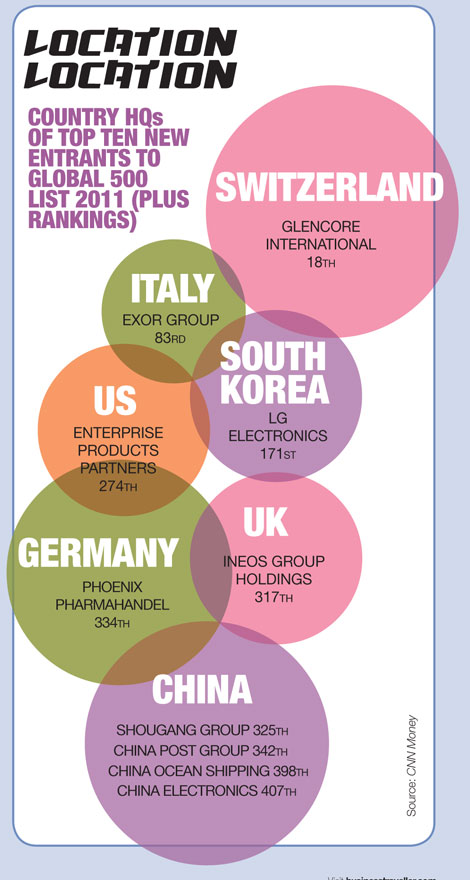Jenny Southan reveals ten top business cities of the future
At some point this month, the number of people you are sharing the planet with will reach seven billion. About 60 per cent of them will be living in Asia. Chances are you are already jetting back and forth to this part of the world, busily brushing up on your Mandarin (if you have any sense) and mastering the art of the bow.
Still, the secret to long-term success is not simply securing that business deal in Singapore or Hong Kong but predicting where you could next be forging contracts. Adam Newton, manager of business environment and strategy for Shell, says: “Our projects are often worth billions of dollars and expected to run over a number of decades. My team has to gain an understanding of what the world will be like in 20 years’ time, taking into account political and economic shifts without being distracted by near-term volatility.
“You have countries such as China that are now reaching the most aggressive part of their economic growth, and, with it, millions of people are coming out of poverty for the first time.”
As travel patterns shift, airlines and hotels have to be ready to cater to new demand. Paul Edgecliffe-Johnson, senior vice-president and chief financial officer for Europe, Africa, Middle East and Asia at Intercontinental Hotels Group, says: “We have 1,190 hotels scheduled to open over the next three to five years. That includes 142 in Greater China, which will almost double the size of our business there.”
So what are tomorrow’s business cities going to be like, and where will they be located? Martin Raymond, co-founder of trend forecasting and research consultancy the Future Laboratory, says: “If you think about the eighties, what defined cities such as London, Paris, Hong Kong and Singapore was ‘muscular’ business activity – they were financial, pharmaceutical, corporate. But cities such as Toronto, Montréal and Melbourne are ‘female’ cities. They are intelligent, smart, cultured, livable and sustainable – these are the cities of the future.”
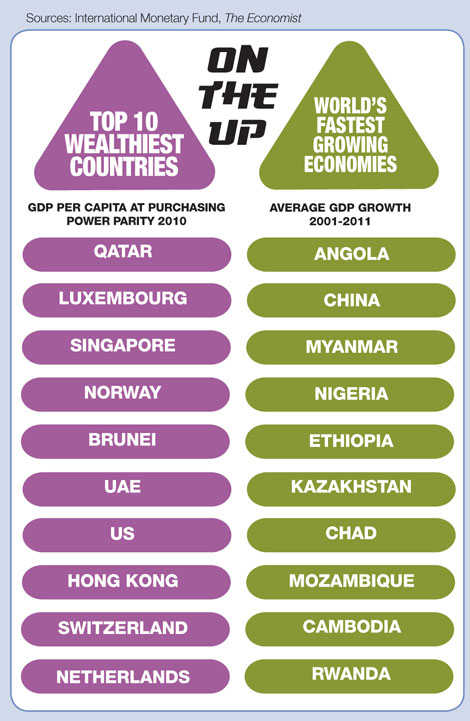
He adds: “If you are under 30, as entrepreneurs increasingly are, and a woman, the cities that represent the old values of business will bore you to death. In Europe you have had Milan as the industrial city of interest in Italy, but we know Rome is coming back on the map and, interestingly, Naples, which has all the rawness and touch points that ignite creativity. You are also seeing Tallinn, Berlin, Prague and Riga coming up.
“In the US, it’s all about Seattle, Austin, Boulder and Santa Fe, because these are the kinds of places that attract third-generation startups – they have young populations and people who take risks. Businesses are now avoiding cities where there is monoculture and conservative thinking.”
While there is no doubt that the BRIC countries of Brazil, Russia, India and China will soon be vying for the title of “economic superpower”, over the next 40 years countries such as Nigeria, Iraq and Mongolia will also become key players. Ben Derudder, professor of human geography at Ghent University, has worked with Loughborough University to establish a global cities ranking (see our data visualisation below). He says: “As these emerging markets become more important, they will continue to rise. So 20 years from now, the cities that will be ranked higher than they are now will be Mumbai, Sao Paulo, Shanghai and most in the Middle East.”
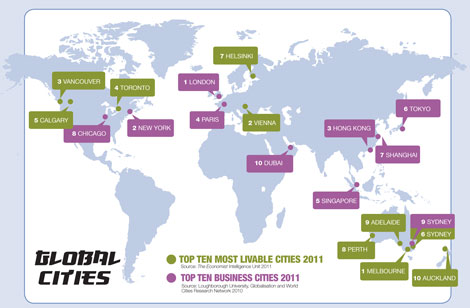
One new trend is building state-of-the-art “planned” metropolises that are sustainably designed, wired with smart technology and that incorporate the best urban features of existing cities, such as New York’s Central Park or the canals of Venice. Tom Murcott, executive vice-president and chief marketing officer for US real estate firm Gale International, which is developing Songdo in South Korea and Meixi Lake in China, says: “Millions of people are relocating from rural areas into cities and the infrastructure is straining to accommodate them. There is a dramatic need for this kind of city.
“If you believe what the experts are saying, that China needs 500 of them and India needs 300 in the foreseeable future, and each one is a US$40 billion undertaking, that’s some pretty significant maths. We’ve had interest from Vietnam, India, South America, Brazil and the Middle East.”
Still, not everyone will be able to live in high-tech “aerotropolises” – cities built close to airports – and so, as US journalist and author Robert Neuwirth points out in his TED (ted.com) lecture on “shadow cities”, the slums around Mumbai, Nairobi and Rio de Janeiro will also become cities of the future. Today, he notes, there are one billion people in the world living in shanty conurbations, and by 2030, there will be twice that.
Jean Robert Saintil, editor of chorusandecho.com – a website that “curates global intelligence to give a deeper understanding of cities” – and co-author of the Courvoisier City Upgrade report, agrees: “People are moving to them en masse not because they want to be poor but because they want to work. They are moving out of poverty. These slums are now growing organically into becoming legitimate parts of the city and centres for innovation.”
Here are ten cities you could soon be visiting…
MEIXI LAKE, China
-
POPULATION 180,000 (when complete)
-
SIZE 6.5 sq km
Meixi Lake is a futuristic new development located outside Changsha in the Hunan province of south-central China. Work began on it in 2009 and, when complete in 2020, it will comprise a high-rise central business district surrounding a 40-hectare lake, with eight neighbourhood “clusters” each housing 10,000 people.
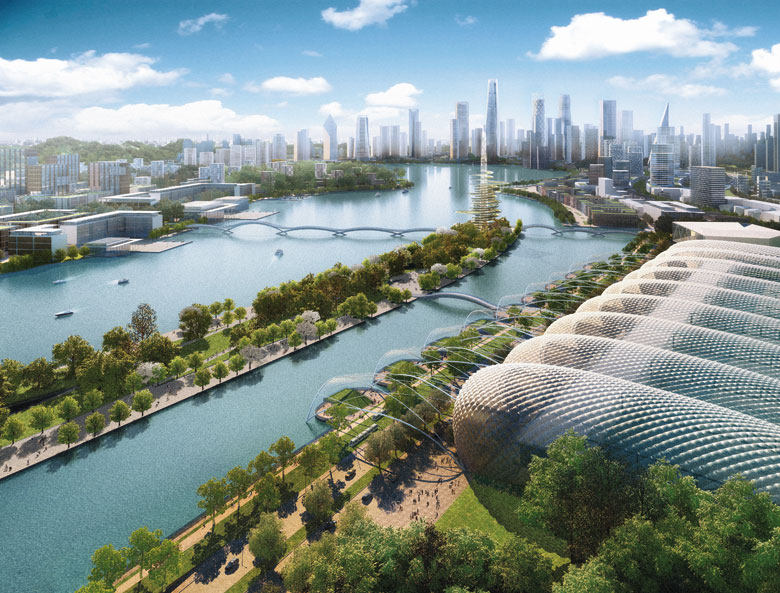
Careful attention is being paid to creating gardens, waterways, micro farms and natural landscaping, as well as integrated sustainable design such as water harvesting and energy-efficient housing. Masterplanner Kohn Pedersen Fox describes it as “a new model for the future of the Chinese city”.
Meixi Lake will form the hub of the West Changsha Pioneer Zone and will feature an extensive education, research and design sector. There will also be healthcare facilities, shopping malls, a five-star hotel and a convention centre. The project, which is modelled on Songdo, is being developed by Gale International in association with communication technology provider Cisco Systems, which will help to install “telepresence” video-conferencing capabilities throughout the homes and offices. Visit kpf.com, gale.mydelphic.com
NOVOSIBIRSK, Russia
-
POPULATION 1.4 million
-
SIZE 503 sq km
Invest in a good pair of gloves because icy Siberia may soon be beckoning. Russia’s third-largest city, Novosibirsk, is 2,800km east of Moscow and is already attracting international hotel groups.
A spokesperson for Rezidor says: “Most of our contract signings are in emerging markets. We’ve seen demand in Moscow and St Petersburg skyrocket over the past decade and now we are focusing on expanding to major regional cities such as Novosibirsk, Ekaterinburg and Tyumen. These are industrial cities with large populations and increasingly diversified economies.”
Novosibirsk specialises in electricity, oil, water and gas supply, mechanical engineering and metallurgy, but is also seeing a significant rise in sectors such as banking, high-tech and education. The “Silicon Forest” of Akademgorodok (so called because it is set in a vast swathe of birch and pine trees), 30km away, has a university, 35 research institutes and the Russian Academy of Sciences.
The “Gateway to Siberia”, Novosibirsk is connected by the Trans-Siberian Railroad and has an international airport, Tolmachevo, which has seen 25 per cent growth in passengers over the past year. One of Russia’s fastest-growing airlines, S7, which joined the Oneworld alliance last year, is also headquartered here.
ULAN BATOR, Mongolia
-
POPULATION 1.1 million
-
SIZE 4,700 sq km
Also linked by the Trans-Siberian rail line is the capital and largest city of Mongolia. No longer a country recognised primarily for its nomadic peoples, camels and yurts, its energy-hungry neighbours of Russia to the north and China to the south are ferociously importing its abundant natural resources of copper, coal, gold, uranium, zinc – the Gobi Desert’s Tavan Tolgoi is the biggest undeveloped coking coal reserve in the world. The US, too, is showing interest, and in July it was announced that Mongolia had chosen Peabody Energy from the United States as one of the potential developers for the Tolgoi deposit.
With Ulan Bator at the helm of Mongolia’s boom – its economy is expected to grow 8 per cent this year, and the tugrik performed better than any other currency in 2010 – its citizens are getting rich fast. Armani, Burberry, Louis Vuitton and Hugo Boss have all opened stores here in the past few years.
It has been suggested that with the government planning to distribute a portion of the profits from mining to Mongolian nationals, thanks to the introduction of a sovereign wealth fund, from 2013 the majority could be lifted out of poverty. Citigroup cited Mongolia as one of the top ten countries with the most potential for growth over the next 40 years.
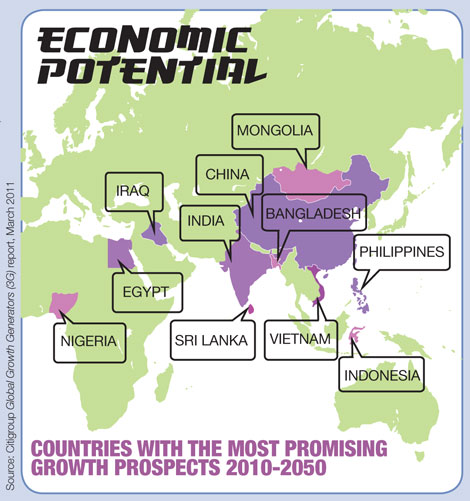
CHONGQING, China
-
POPULATION 32 million
-
SIZE 82,400 sq km
At the intersection of the Yangtze and Jialing rivers in southwest China, Chongqing is one of the fastest growing urban centres on the planet, with a population already greater than that of Malaysia thanks to the hundreds of thousands of people relocating from the countryside each year. In a bid to offset its carbon emissions and improve the quality of living for its residents – who endure more than 100 days of fog annually – the authorities are planting millions of trees with the aim of creating 17,000 sq km of woodland within five years.
The hilly megalopolis is well on its way to being a major business hub, with global companies such as Wal Mart, Mazda and Deutsche Bahn already having a significant presence. Chongqing has a number of major universities, is a leader in car and motorbike manufacturing, and a centre for the production of steel, aluminium and iron. The region is also rich in coal, natural gas and minerals, and a giant crude oil refinery operated by China National Petroleum Corporation is to be built by 2015.
The government is encouraging Chongqing to expand into high-tech manufacturing, with the 130 sq km New North Zone, which was established in 2002, dedicated to IT, biopharmaceuticals, software development, medicine, chemicals, clothing and genetically modified food. Last year it saw an output value of just over US$4 billion.
SONGDO, South Korea
-
POPULATION 70,000 residents, 300,000 workers (when complete)
-
SIZE 6 sq km
Songdo is branding itself as a “smart, sustainable reality that is one of the world’s greenest cities” and, at only 11km away from Incheon International airport, one that connects travellers to “a third of the planet’s population within 3.5 hours”. It is in its second construction phase – the first was completed in 2009 – and there are about 20,000 people living and another 25,000 working in the city, but by the time it’s finished in 2016, these numbers should have risen steeply.
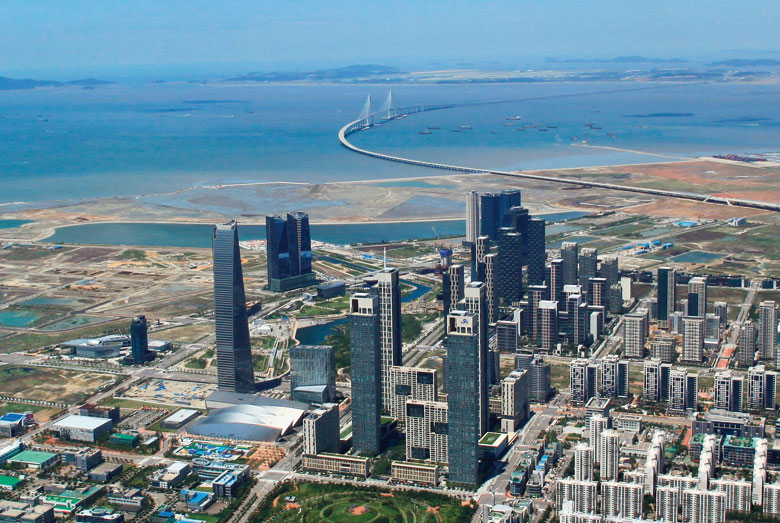
Korea’s tallest building, the 68-floor North East Asia Trade Tower (NEATT), will be unveiled at the end of next year in Songdo’s business district (also a Free Economic Zone), and numerous other office blocks will be erected over the next few years, as well as 22,500 housing units, a world-class healthcare facility, and a cultural complex with an opera house and a design school.
Gale International’s Murcott says: “Walking around, you see people strolling in the park, attending weddings at the Sheraton Incheon hotel, visiting an exhibition at the convention centre, or playing a round at the Jack Nicklaus Golf Club. It’s a living, breathing city – it’s up and running.” It is anticipated that the entire city will achieve LEED (Leadership in Energy and Environmental Design) certification and, like Meixi Lake, will be wired with Cisco telepresence technology. Visit songdo.com
CHANDIGARH, India
-
POPULATION 1 million
-
SIZE 114 sq km
The North Indian city of Chandigarh, which sits at the foothills of the Himalayas and serves as the capital of both Punjab and Haryaba, may not be as well known as other emerging Indian cities such as Hyderabad, Gurgaon, Pune and Ahmedabad, but it has a lot going for it. Chandigarh’s residents enjoy one of the cleanest cities in India, the highest income per capita, and an 80 per cent literacy rate. The city is also renowned for its good urban planning thanks to the father of modern architecture, Le Corbusier, who designed it.
The Future Laboratory’s Raymond says: “Chandigarh is one of the cities that is going to happen over the next five years because of its architectural associations – it’s a bit like [Australian capital] Canberra in that it’s laid out in a classical way – and because it’s always had India’s ‘quiet but dignified’ universities.”
Banking is big here, as is defence, government, paper manufacturing and pharmaceuticals, but outsourcing and IT are the future, with Chandigarh Technology Park providing a base for companies such as Infosys and IBM since its inauguration in 2005. The city is three hours from Delhi and its new international airport terminal opened in April. JW Marriott opened its first North Indian hotel here in July, and Park Plaza (see page 49), Starwood and Hyatt will be arriving soon.
MASDAR CITY, UAE
-
POPULATION 40,000 residents 50,000 workers (when complete)
-
SIZE 6 sq km
If you thought Songdo and Meixi Lake were impressive, consider Abu Dhabi’s ambitious Masdar City, designed by UK architects Foster and Partners and located by the airport. It is set to become the world’s first “zero-carbon” city, as it will be powered by the sun, and will be entirely free of cars.
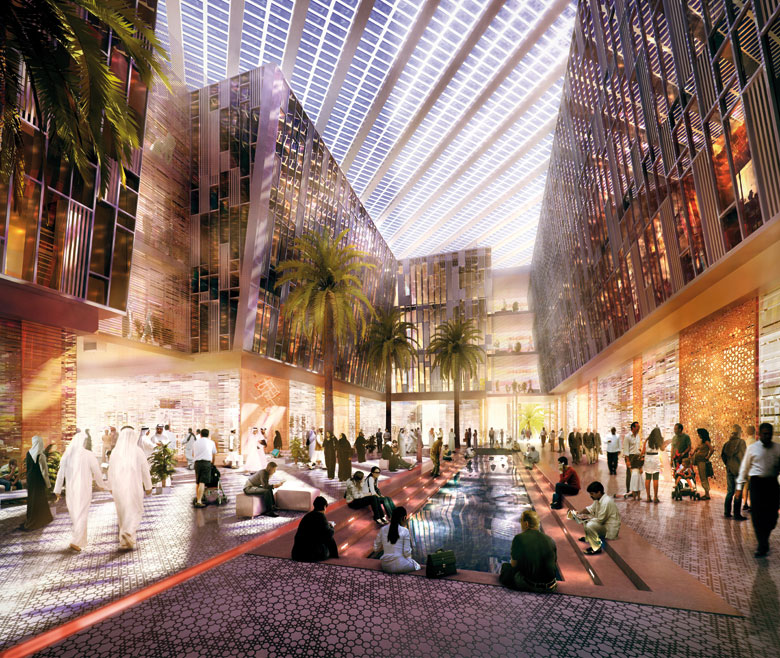
Costing about US$20 billion and with completion scheduled for 2016, the low-rise desert hub will boast the largest solar farm in the Middle East and 80 per cent of its water will be recycled. Beyond the boundaries of the city walls will be cool air conditioned homes and offices, eco-friendly driverless solar podcars, narrow shady streets and a university. It’s hoped that it will attract entrepreneurs and those working in cleantech, finance, research and innovation.
The first six buildings in the Masdar Institute campus are complete, while the Masdar HQ, which will produce more energy than it consumes, and the first commercial building, the 10,000 sqm Courtyard, will be open by 2013. Many dozens of companies have registered for office space, and will be able to reap the benefits (such as no taxes or import tariffs and 100 per cent foreign ownership) of being in a Special Economic Zone when up and running. Visit masdarcity.ae
LUANDA, Angola
-
POPULATION 5 million
-
SIZE 2,257 sq km
The capital of Angola, and also its main port, Luanda has put its Civil War days behind it. Since fighting ended in 2002, stability has returned and a reconstruction boom has taken hold – a satellite city (Luanda Sul) has been built, housing is going up to offer an alternative to the slums, and new roads are being laid. Although more than 50 per cent of its rising population live in poverty, it was ranked the most expensive city to live in for expats in a survey by consulting firm Mercer (mercer.com) earlier this year.
Luanda has one of the world’s fastest growing economies. Over the past five years, it has seen more than 60 per cent growth in gross national income per capita. Manufacturing of building materials, cigarettes, clothing, processed foods and textiles has contributed to this, along with exports of coffee, diamonds, sugar, iron, salt and cotton. Oil extraction and petrol refinement are also big income generators.
A new international airport that will be the largest in Africa is nearing completion, a new terminal opened last year at its Quatro de Fevereiro International airport and a number of airlines, including Iberia and KLM, have announced new routes to the city. Henri Hourcade, KLM’s general manager for the UK and Ireland, says: “Angola is experiencing strong economic growth, it is a key oil exporter and foreign investment in the region is increasing rapidly. We see high potential in this twice-weekly new route [from Amsterdam Schiphol, starting November 14].”
GUADALAJARA, Mexico
-
POPULATION 1.5 million
-
SIZE 151 sq km
Second only to Mexico City in terms of population, Guadalajara is the country’s cultural hub, being the birthplace of Mariachi music and home to the annual International Film Festival of Guadalajara and the 2011 Pan American Games. Many multinational firms have been setting up manufacturing plants to take advantage of the cheap yet skilled labour force, with textiles, shoes, food, steel and pharmaceuticals all in production. The city has also become known as the “Silicon Valley of Mexico” because of its emphasis on IT – Siemens, Hewlett-Packard and General Electric are all based here.

About 40 per cent of Guadalajara’s commodities are exported to the US. The Future Laboratory’s Raymond says: “Mexico gives you the ‘hourglass effect’ – you push through the bottom and go into South America and push through the top and go into North America, giving you access to two premium markets.”
Guadalajara also scores points because of the high number of young people who live there, low unemployment, high literacy rate, good office and convention space, extensive public transport, and the large number of foreign investors.
CURITIBA, Brazil
-
POPULATION 1.8 million
-
SIZE 430 sq km
Although the International Monetary Fund expects Brazil to lag behind other BRIC countries Russia, India and China over the next three years in terms of growth, Rio de Janeiro and Sao Paolo have been working hard to establish themselves in the global business network. At the same time, with the country still an emerging economic giant, it is likely that other Brazilian cities will discover the limelight over the next two decades.
Curitiba is the capital of the southerly state of Parana and is known for offering a high quality of living thanks to award-winning sustainable urban planning, social housing, a world-class bus network, low air pollution, plenty of green space (52 sqm per person), bike paths and an innovative waste management scheme. The government has also earned praise for building 50 educational centres, known as “Lighthouses of Knowledge”, with libraries and internet access so poorer people can educate themselves.
UNESCO deemed Curitiba a model for the rebuilding of cities in Afghanistan after the US invaded in 2001. Car manufacturing is huge, with Nissan, Volvo and Audi having a presence here, along with representatives from other sectors such as consumables (Kraft Foods) and energy (Exxon Mobil). Because Curitiba offers an English-proficient workforce and salaries that are lower than other Brazilian metropolises, outsourcing, particularly in IT, is also becoming popular, with HSBC Global Technologies, Accenture and Wipro moving in. Alfonso Pena airport, only 17km from the centre, is one of the best in the country.
